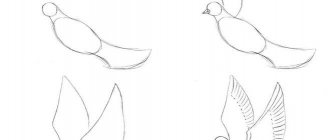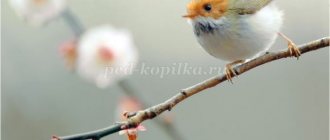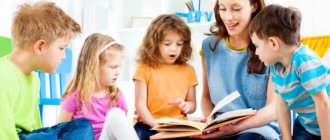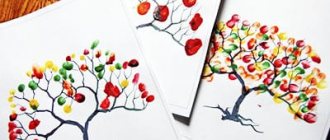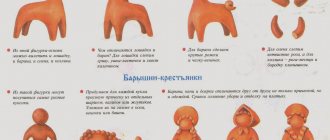Svetlana Gayazieva
Goals: improve bird
; develop creative imagination;
cultivate a caring attitude towards the environment; correctly determine and depict the shape of objects, their proportions; observe the sequential execution of the drawing; cultivate a love for birds.
Materials: Album sheets, gouache, brushes, palette, jars of water, napkins, oilcloths, educational video
«
Starling
«.
Preliminary work: viewing illustrations of migratory birds
;
reading poems, stories; watching educational videos
, bird watching
on walks
.
Summary of a drawing lesson in the senior group “Birds of Migratory”
Summary of a drawing lesson in the senior group “Birds of Migratory”
Kind of activity:
direct educational
Age group:
senior group
Subject:
"Migratory birds"
Target
: consolidate methods for conveying bird proportions; develop creative imagination; cultivate a caring attitude towards the environment; consolidate and expand knowledge about wintering and migratory birds. We continue to develop fine motor skills; observe the sequential execution of the drawing; cultivate a love for birds.
Software tasks:
Educational:
- practice drawing birds;
- consolidate the methods of making a sketch with a simple pencil and then painting over it with watercolors;
Educational:
- develop the ability to analyze drawings;
-develop memory, thinking, fine motor skills of the hands, and the ability to enjoy the results of one’s work.
Educational:
— caring attitude towards birds and nature;
- to form in children the desire to complete the work they start.
Methods and techniques:
-Visual: looking at illustrations (paying attention to the characteristics of birds - size, color, leg length, beak shape).
-Verbal: conversation, explanation;
Preliminary work:
looking at illustrations of birds, viewing slides “Migratory Birds”.
Material and equipment:
pictures of birds; drawing paper, pencil, eraser, watercolor, brushes, water jar, palette.
Progress of educational activities:
Educator:
- Let's see what birds are sitting on our tree? Name them. (crow, magpie, woodpecker, tit, black grouse)
- Oh, guys, I can’t understand something, are all the birds gathered on the tree? Help me to understand. (Children find out that all birds winter and there are no migratory ones.)
- What happened? Where have the migratory birds gone? (children's answer)
- Guys, let's think, why are birds called migratory? That's right, migratory birds are birds that come to us in the spring, and in the fall they fly to warmer climes. Why do these birds fly away from us in the fall?
-All these birds eat insects. And in the fall the insects disappear. Birds are deprived of their main food and are forced to fly to warmer climes. There are many insects there all year round. Let's list the migratory birds (swallow, crane, stork, cuckoo, swan, starling, wagtail, duck, lark, heron)
- Please look at all of these and name their similarities and differences. (similarities are the body, head, tail, etc.; differences are the color of the plumage). You and I have already drawn a bird with a pencil. Today we will also draw with paints.
Physical exercise “A flock of birds is flying south”
A flock of birds flies south, the sky is blue all around. (Children wave their arms like wings) In order to fly faster, you need to flap your wings. (Children wave their hands more intensely) The sun is shining in a clear sky, An astronaut is flying in a rocket. (Stretching - arms up) And below the forest, fields - The earth is spread out. (Low bend forward, arms spread to the side)
The birds began to descend
Everyone sits down in the clearing.
They have a long way to go, the birds need to rest. (Children sit in a deep squat and sit for a few seconds) And again it’s time to hit the road. We have a lot of flying to do. (Children stand up and flap their “wings”)
Here comes the south. Hooray! Hooray! It's time for us to land. (Children sit at tables)
- Now look at these pictures. Let's name what parts a bird consists of? (head, body, tail, wings) What shape is the head? (round) What shape is the body? (oval) What shape is the tail? (can have a triangular shape, or can be forked, like a swallow) The wings have a curved shape if the bird is flying, and oval when folded. The beak is triangular.
— You know how to draw geometric shapes. Therefore, you can easily depict the components of birds. You just need to connect them correctly.
Practical part:
-First, let's draw an oval body. Then we will draw the head. Oval wings, slightly pointed at the ends - these are the longest feathers. Rectangular tail, triangular beak, round eyes. And then, let's draw the paws, draw the feathers.
— We take simple pencils and make sketches. (children draw). Then we will paint our bird with paints and create a background.
Result:
- Well done boys. You all did your best and we got wonderful birds.
— What migratory birds do we know?
-Well done guys, you did a very good job today. With each lesson your work gets better and better! Well done!
After class, the work is displayed in a corner along with the original pictures, so that other children can look and compare.
Summary of a drawing lesson in the senior group “Migratory Birds. Starling" Video
Svetlana Gayazieva
Summary of a drawing lesson in the senior group “Migratory Birds. Starling" Video
Goals: improve skills in depicting birds ; develop creative imagination;
cultivate a caring attitude towards the environment; correctly determine and depict the shape of objects, their proportions; observe the sequential execution of the drawing; cultivate a love for birds.
Materials: Album sheets, gouache, brushes, palette, jars of water, napkins, oilcloths, educational video “ Starling ”.
Preliminary work: viewing illustrations of migratory birds ; reading poems, stories; watching educational videos , bird watching on walks .
Leave your comment
Gift certificates
Responsibility for resolving any controversial issues regarding the materials themselves and their contents is taken by the users who posted the material on the site. However, the site administration is ready to provide all possible support in resolving any issues related to the work and content of the site. If you notice that materials are being used illegally on this site, please notify the site administration using the feedback form.
All materials posted on the site were created by the authors of the site or posted by users of the site and are presented on the site for informational purposes only. Copyrights for materials belong to their legal authors. Partial or complete copying of site materials without written permission from the site administration is prohibited! The opinion of the administration may not coincide with the point of view of the authors.
Source
Specific options within the theme “Birds”
According to T. Komarova’s fine arts program, in the preparatory group two lessons are devoted to drawing birds: this is drawing an illustration for the work of Mamin-Sibiryak “The Gray Neck” and “The Magic Bird”. However, the topic of birds is so interesting and multifaceted that the teacher clearly should not limit himself to only this. So, options for the feathered theme could be as follows:
- Owl-owl (a very bright image that can be depicted in different techniques).
- A flock of migratory birds (theme is proposed in autumn or spring).
- Cockerel is a golden comb (can be associated with some fairy tale, for example, “The Cockerel and the Bean Seed” or “The Tale of the Golden Cockerel” by A. S. Pushkin).
- Titmouse (you can draw on November 12 or not far from this date, when people celebrate Titmouse Day).
- Bullfinches on a branch (of course, this theme is offered in winter).
- Swallow (it’s good to connect the image with the fairy tale “Thumbelina”).
- Poultry (poultry yard as an option). A child can simultaneously portray a chicken, a rooster, a duck, a goose, a turkey, or one or the other.
- White-sided magpie.
- Swan on the lake (as a variant of the swan princess of A.S. Pushkin before her transformation into a girl or an illustration for Andersen’s fairy tale “Wild Swans”).
- Kargopol birds (drawing based on folk toys).
- Fairytale bird (Firebird).
Older preschoolers always find collective compositions interesting. The “Magic Bird” work is popular, when each child paints a feather to his own taste, and then a gorgeous tail is assembled from them (the teacher prepares the base in advance - the body of the bird).
Each child paints the feather according to their wishes, and together they make up the original tail of a fairy-tale bird.
Here again, you can take an individual approach and invite some children to color two feathers.
Another option for joint creativity is “Birds at the feeder.” The teacher draws a tree with branches and a feeder, and preschoolers complete the composition with birds.
The theme “Birds” encourages the creation of collective compositions
drawing migratory birds outline of a drawing lesson (senior group)
Drawing lesson notes
"Migratory birds"
(senior group)
Tasks:
Teach children to draw migratory birds, building an image from its component parts.
Develop skills in drawing a sketch of a picture with a simple pencil.
Consolidate and expand knowledge about wintering and migratory birds.
Cultivate a caring attitude towards birds.
Materials:
Recorded bird voices, image of a tree, pictures of wintering and migratory birds, magpie, letter, samples for drawing birds.
Progress of the lesson :
(The voices of birds are recorded. Children with a teacher enter the group)
Educator:
- Let's see what birds are sitting on our tree? Name them. (Woodpecker, tit, crow, magpie, black grouse)
- Oh, guys, I can’t understand something, are all the birds gathered on the tree? Help me to understand. (Children find out that all birds winter and there are no migratory ones.)
- What happened? Where have the migratory birds gone? But here is some letter from the magpie, let’s take the letter from the magpie and read it.
- Oh, children, an accident happened. It turns out that the Snow Queen, the mistress of winter, captured the birds on the way to the south and does not want to release them into the wild. The birds are asking for your help.
“The snow queen is probably bored of being alone and that’s why she doesn’t want to let the birds go.” I suggest drawing portraits of birds and giving them to her. And then she will release all the birds.
- Guys, let's think, why are birds called migratory? That's right, migratory birds are birds that spend half the year with us, and leave us for the second half of the year, flying to other lands. Why do these birds fly away from us in the fall?
-All these birds eat insects. And in the fall the insects disappear. Birds are deprived of their main food and are forced to fly to warmer climes. There are many insects there all year round.
Physical exercise “A flock of birds is flying south”
A flock of birds flies south, the sky is blue all around. (Children wave their arms like wings) In order to fly faster, you need to flap your wings. (Children wave their hands more intensely) The sun is shining in a clear sky, An astronaut is flying in a rocket. (Stretching - arms up) And below the forest, fields - The earth is spread out. (Low bend forward, arms spread to the side)
The birds began to descend
Everyone sits down in the clearing.
They have a long way to go, the birds need to rest. (Children sit in a deep squat and sit for a few seconds) And again it’s time to hit the road. We have a lot of flying to do. (Children stand up and flap their “wings”)
Here comes the south. Hooray! Hooray! It's time for us to land. (Children sit at tables)
- Now look at these pictures. Looking at them, we understand that the body of birds consists of several parts. Which ones? (head, body, tail, wings) What shape is the head? (round) What shape is the body? (oval) What shape is the tail? (can have a triangular shape, or can be forked, like a swallow) The wings have a curved shape if the bird is flying, and oval when folded. The beak is triangular.
— You know how to draw geometric shapes. Therefore, you can easily depict the components of birds. You just need to connect them correctly.
(Show)
-First, let's draw an oval body. Then we will draw the head. Oval wings, slightly pointed at the ends - these are the longest feathers. Rectangular tail, triangular beak, round eyes. And then, let's draw the paws, draw the feathers.
— We take simple pencils and make sketches.
(children draw)
Result:
- Well done boys. You all did your best and we got wonderful birds. I think the snow queen will be pleased and will definitely let our feathered friends go.
— What migratory birds will we wait for?
Game: “Find the migratory bird”
- You all completed the task. I will give you all invitation tickets to the Birds of Migratory quiz.

